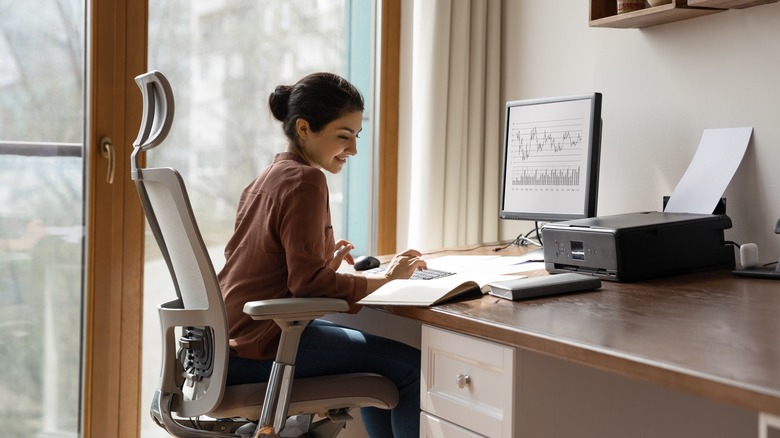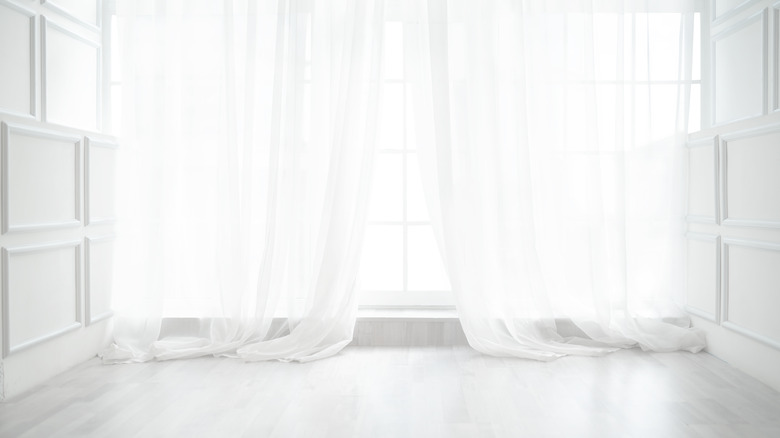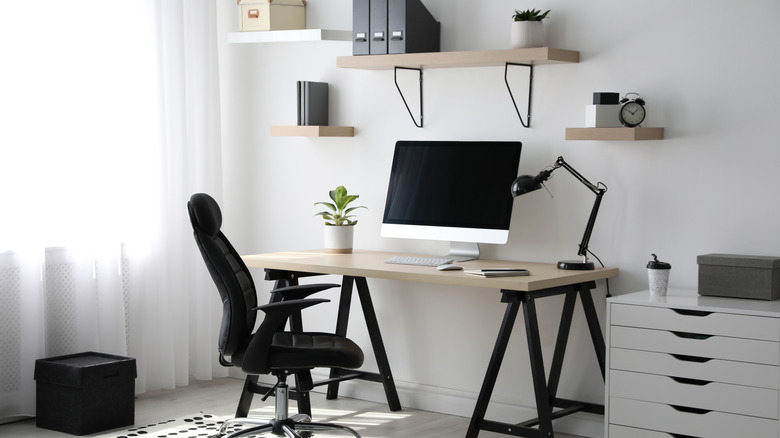How To Create A Workspace In Your Small Bedroom, According To A Design Expert
Working from home has become the norm for many people in the United States. While this is an enviable situation, it does require some thought about how to set up the ideal workspace. Many homeowners try to sandwich a home office into a part of the home that isn't conducive to work. Moreover, The Wall Street Journal notes that one of the worst design options that a homeowner can make is to use an undersized desk in a windowless part of the home.
In an exclusive interview with House Digest, Carmen Molina, designer and project manager from Freemodel, offers some crucial insights into how to design a functional workspace even if you have a small home. She notes, "smaller doesn't have to mean less comfortable or having less room to be creative and make the best of our favorite spaces in the house." Sometimes the best location to set up an area to work from is the bedroom. Molina recognizes that "some people like their bedroom to be a restful sanctuary and adding a working space, such as a desk, is not in their plans." But, if options are limited, she recommends several ways to optimize your room and create an area that is both functional and stylish.
Bring in the right furniture
Bedrooms, even small ones, can be productive workspaces and this task starts with the furniture. Molina suggests "adding a small desk under a window, or creating a reading space by adding a small armchair or tall bookshelves on one or both window sides." This, she says, "can give your bedroom workspace a cozy and inviting feeling. A long chaise or a cute bench with cushions on it achieves this effect as well." By choosing the right pieces of furniture and a complementary layout, you can create a comfortable office feeling without spoiling the look of your bedroom.
Not only should you focus on pieces of furniture that can improve your work environment, but Molina also notes a few things to shy away from. She says, "avoid bulky desk chairs if possible. Chances are you can find a sleek, comfortable, and beautiful chair for your desk without spending a fortune and without compromising the rest of your decoration." Cohesiveness is a crucial element, and in a smaller room, keeping the dimensions of each piece that you'll be adding to a minimum will prevent it from dominating the space. She also suggests stylistic additions to complete the furniture, saying, "a cute antique table or secretary would add interest and character to any workspace."
Lighting for your bedroom workspace
Lighting is a core component of any workspace. Having ample light to see the things you're reading, writing, or studying can make or break your home office environment. For many, natural light remains a high priority, but when the sun goes down, additional light sources will be required. Molina has some useful advice on choosing appropriate lighting for your working environment. She explains, "there are some very beautiful lamps with articulated arms that you can bring closer to you for reading and then fold away once you don't need them."
However, she cautions against the use of certain lighting elements, saying, "avoid big chandeliers and pendant lights unless you have very high ceilings. I personally like indirect lighting better because it allows me to play with different light tones. Floor lamps are not a good choice for a small room. They can take the space a small storage bench or a chair could have." As with any other part of the home, functionality and comfort are driven in large part by the ambiance set by your lighting. It is important, therefore, to select fixtures that ensure productivity yet don't make the area feel sterile and unhomely.
Dress windows accordingly
Molina also focuses on the stylization of the windows. Natural lighting is an important element of a home office, but the type of window dressings you choose can help to maximize the space and amplify your productivity. She says, "if you like curtains and are lucky enough to have a big window, always choose ceiling-to-floor drapes because it gives the impression of taller ceilings. Avoid valances and short curtains in small rooms. If you have a small window and are up for a challenge, covering that whole wall with panels and sheers will give the impression of your room having a bigger window."
Molina also offers some advice on choosing the best material for window dressings, saying, "playing with color here can be a lot of fun; just avoid big patterns when choosing curtains." Color coordination is a big deal in any decorating task, and is particularly important when designing a workspace, bold patterns may look good, but they may also make it difficult to focus on the job at hand.
A word on colors and sizing
Lastly, Molina suggests focusing on the use of sizing and color combinations that add depth and character. She states, "in general, with furniture in a small room, avoid dark colors. Natural wood tones, light gray, white — those are colors that will bring in harmony and give a better distribution of light." Lighter colors provide airiness to the space and can help establish a calming and productive environment that allows you to conduct work at your best level.
She also notes that sizing is a crucial consideration that can establish the confines of the work environment. She says, "refrain from introducing bulky items such as a big chair or table. Be consistent with the size of the pieces chosen for your bedroom workspace. For example, a minimalist desk would look out of place next to a big desk chair." It might be tempting to just use any available items of furniture that you already own. However, by being intentional with your choices and ensuring each item is a good fit, you can create an office that blends well with your bedroom, rather than one that looks like an afterthought.




